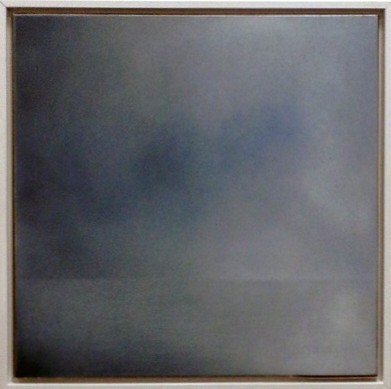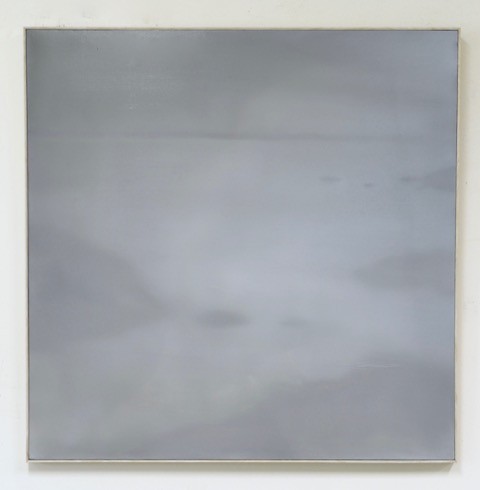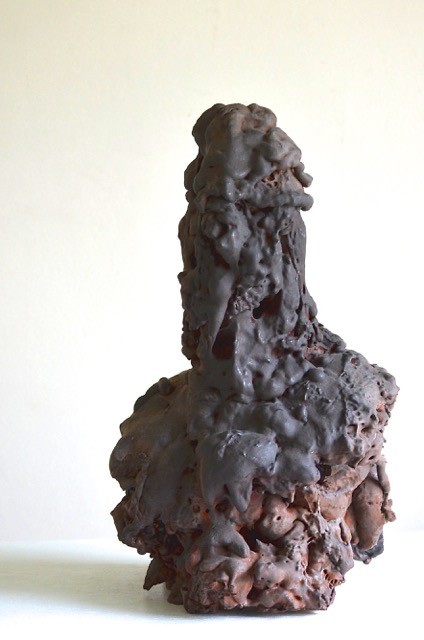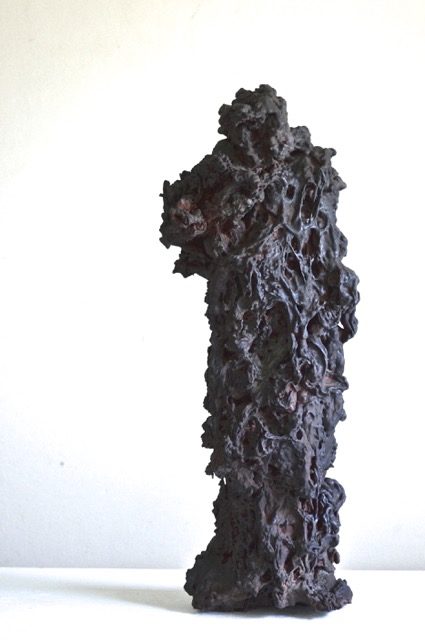Matthew Metzger’s new collection of paintings and sculptures at Moremen Contemporary straddles a difficult line between past and present. These works embrace an approach to materials and process that echoes tradition while carving out a place to thrive and reassess that tradition in new and immediate contexts.
At first glance Metzger’s paintings are highly polished snapshots of dense and misty skies. They recall Constable’s or Turner’s nineteenth century studies of voluminous cloud formations, or Whistler’s later atmospheric images of night skies obfuscated by titles that referenced music or color. Such images of the sky already blur distinctions between the abstract and figurative. To this extent a hazy sunset and similarly hued color field might only be distinguished by a descriptive title or logically placed line that imitates a horizon.
Metzger’s paintings oscillate between these divisions very subtly. Paintings of similar luminous mists or fog feature diverse titles that describe mountains, seas, people, and colors. There is a sense that each painting’s depiction of atmosphere is much more complex than a simple record of weather conditions. The word “atmosphere†can describe both a cloudy landscape and its pervading emotional effects. Metzger’s paintings suspend these dual prongs in such a way that the viewer’s experience engages both definitions in a direct, meaningful, and very present way.

It is probably unimportant that these images, to the extent that they are only images, have a basis in observations. The atmospheres that Metzger has created in and on his paintings exist wholly in the paintings themselves. The way he has combined constituent parts, pigments, oils, canvas, linen, and wood, results in objects with a tangible presence that can be readily perceived by the viewer.
An example is seen in Metzger’s Seascapes series. Each of the five small square paintings show (vaguely) views of dense and foggy skies over similarly colored water. Four of these paintings are arranged in a line creating a sense of both commonality and atmospheric development. In the fourth painting, on top of its swirling mists and faint luminous light, a sharp nearly three-dimensional line abruptly cuts across the painting’s lower half. What initially appears to be a horizon cutting between water and sky actually pokes outward towards the viewer. This breaks both the illusion of the image and the viewer’s own illusions about what the picture might purport to be. This cut is a reminder that canvas presents a tenuous bridge between object and image, one that can be quickly shattered by a single line. The suggestive nature of their titles and the viewer’s ready acceptance are deftly questioned by this subversion.

It seems that the most important part of these paintings is Metzger’s interest in his media. He produces his own paints and mixes them from sourced pigments. Again this recalls tradition, where painters of the past put great effort into the preparation of their paints. But here the deliberateness of Metzger’s choice has deep ramifications in the finished products. The colors swirled throughout Water for Jim Harrison pull the atmosphere away from an initially recognizable image of land and water towards the reality of its paint, canvas, and even colors as a mixture of very real materials.
Even the colors are like objects in their own right, molecules of pigment deftly smeared across the painting’s surface. Even though it is one of the more recognizably figurative paintings, the atmospheric reality of Water for Jim Harrison protrudes into the viewers space, this time through several textured masses of paint that interfere with the totality of the painting’s illusionistic wholeness.
This blurring of image and object is the same with the artist’s sculptural works. Like the paintings hinting at skies or clouds, the sculptures have forms that hint at the human body. They recall malformed yet still recognizable busts or figures. Yet this is never conclusive especially when close examination reveals connections that move beyond the concept of bare depiction.


Two of the sculptures, Jefferson (Cantos XXI) and Adams (Cantos LXIV), derive their titles from Ezra Pound’s long and fragmentary poem The Cantos. Pound’s cantos can be understood as portraits in poem form that use pieces of their namesakes’ quotations cut and arranged in new ways. The same might be said for the sculptures. They appear to be layered aggregations of parts and pieces that have been dripped on or bubbled out from their surfaces.
The objects are hard and real, produced by the action of acids, polymers, and metals reacting with each other. And on top of that, dust and stray cobwebs further assert this presence in front of the viewer. The realness of these objects cannot be ignored, even if such materiality contradicts their initial human likenesses. Rather, they are reminiscent of bodies at the most basic physical level.
As Metzger explains in his statement, the interactions of the paintings and sculptures offer the viewer a template for contemplation. These are objects meeting one another. For the viewer, this exhibition strives to be more than a set of images that are looked at and thought about. Rather, they are things to be felt and perceived as canvas, pigment, metal, and oil by flesh, blood, and bone. While they don’t breathe the air, their atmospheres are ones that extend beyond depiction and into our shared space.
The exhibition is on view through October 12th at the Moremen Gallery located at 710 W. Main Street in Louisville (Next to 21c Museum Hotel).




